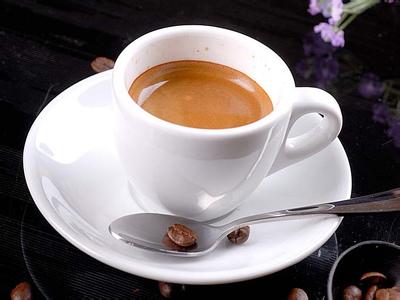Production of Espresso: grinding
The thickness of coffee beans depends on the way they are cooked. Generally speaking, the longer the cooking time, the thicker the ground powder. In terms of actual cooking, American filter coffee takes a long time to make, so coffee powder particles are the thickest, "siphon" coffee powder takes more than a minute to cook, and coffee powder particles are medium in size; Espresso takes the shortest time, so the particles need to be ground the finest. "Grinding Technology School" believes that grinding the right size of coffee powder is essential for the perfect coffee. There is a theoretically ideal time for the extraction of water-soluble substances in coffee powder: if the powder is very fine and boiled for too long, it will cause over-extraction, and the coffee may be very bitter and lose its aroma; on the contrary, if the powder is too coarse to make it boil too fast, resulting in insufficient extraction, the coffee will be tasteless. Particle size can be discussed, and the shape of the grinding blade is also available in flat or tapered shape. one of the technical points about grinding is recognized: it must be ground before cooking. After the coffee bean is ground into powder, due to the increase of surface area, it is easy to absorb moisture and be oxidized, resulting in flavor damage. The limit of placement time provided by some "grinding technology pie" is: 30 minutes.

After grinding the coffee powder, it seems that it is finally possible to make a cup of technical Espresso according to the technical standard proposed by AndreIlly in his book Espresso Coffee: a quality of Chemistry (Espresso Coffee:The Chemistry of Quality). Indeed, Andre Yili belongs to the famous Illy coffee family. The family invented the first automatic Espresso coffee machine to replace steam with compressed air in 1933, which became the prototype of modern automatic Espresso coffee machine, and its technological innovation also accounted for three of the eight historic breakthroughs in the coffee industry. So, no matter which technical school you measure, the standard from the Illy family has become a classic description of some kind of Espresso: "using 7 grams of freshly ground coffee powder, using water at a temperature of about 91 degrees Celsius at 9 atmospheric pressure (Bar), through 25 seconds of extraction to get a cup of about 30 milliliters of coffee drink, the surface of this coffee should be covered with a reddish-brown foam (Crema)."
Andre-Yili also modestly admitted that this standard is only based on his own experience, how to extract a perfect cup of Espresso, the technical discussion has only just begun. For example, senior American barista David Schummel (DavidSchomer) believes that the best Espresso requires 8.2 atmospheric pressure and 95 ℃ cooking temperature. The question that comes with grinding should be, how much coffee powder is put in the filter handle (filterbasket)? How to make powder and press powder? But another technical question often cuts in: where should the filter handle be put in your spare time?
The view represented by Taiwan in Asia is that as most of the aromatic components in coffee powder are volatile, if the handle of the filter is preheated in advance, a large amount of aromatic substances will be lost during filling, which is very harmful to Espresso. The common view in Europe and America is that the filter must be fastened to the group when it is not in use, so that it can preheat and reduce the impact of temperature difference. In his book "Espresso Coffee Specialty" (Espresso Coffee:Professional Techniques), Schummel pointed out: "the effluent of the coffee maker boiler can be maintained at ±1 ℃, but it is another matter to keep the temperature of the head steady. The machines I have tried have a change of at least 6 ℃. The structure of the filter handle itself is a little responsible. It itself is made of heavy metal for the purpose of heat preservation. But the metal is easy to dissipate heat. Take the handle off the machine, put coffee powder in it, and press it. Throughout the process, the metal parts continue to dissipate a lot of heat, and eventually the temperature will be 20 ℃ lower than originally expected. " To achieve optimal temperature control, most commercial Espresso coffee machines for cafes use brass head and stainless steel strainer, but this "luxury" is hard to see on household machines.
Important Notice :
前街咖啡 FrontStreet Coffee has moved to new addredd:
FrontStreet Coffee Address: 315,Donghua East Road,GuangZhou
Tel:020 38364473
- Prev

Espresso production: blending
"Blending" refers to the selection of coffee beans of different origins and qualities to achieve the desired result.
- Next

Production of Espresso: loading powder
Andre Yili has a short sentence of "7g", but in the eyes of some careful people, this stage can be described as "the most difficult step in the cooking Espresso process".
Related
- What is the meaning of lactic acid fermentation with coffee bean treatment?
- How to judge the state of foam by sound?
- How does the latte pull out the unicorn pattern? Come to get for a little trick to improve the flower pull!
- Will flower pulling affect the taste of the latte?
- Do you know the history of coffee?
- The difference between honey treatment and sun washing what is raisin honey treatment?
- What kind of milk can a novice use to make coffee foam to keep the foam longer? The correct method and skills of milking tutorial sharing
- Why do washed coffee beans taste sour? Flavor characteristics of washed Coffee
- Introduction to the skill of how to practice the size and height of water injection around the circle of hand-brewed coffee
- How do beginners practice coffee flower drawing from scratch?

